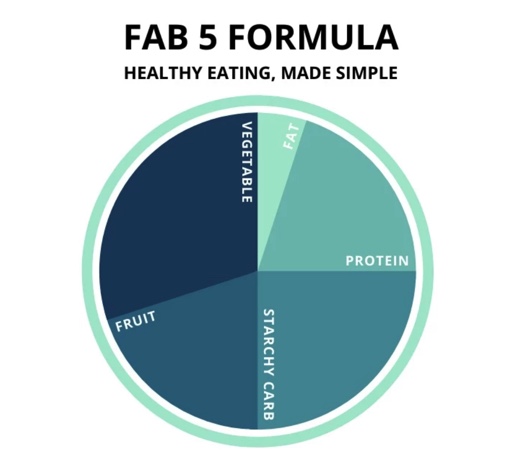Reinvent your relationship with food – the new approach to healthy eating

When we think about healthy eating in terms of dieting, losing weight and getting fit, we often think of the food we can and can’t eat – the focus is on the food itself. But, this new year, instead of purely focusing on what to eat to be healthy, there are strategies you can use to help you achieve a healthy, sustainable and maintainable diet.
In my practice with coaching clients, I see the most positive, long-term results when applying a multi-disciplined approach. Not only is a knowledge of nutrition important but, perhaps more important, is your mindset, your relationship with food, and your habits.
Mind your mindset
One of the most important factors influencing your nutrition is your mindset. What you think about consistently has a direct impact on your actions – and not the other way around. This means, your mindset is the key to turning your intentions into reality.
The typesof mindset that often holds us back is a lack of self-compassion, as well as one of unrealistic expectations. This leads to a warped perspective of how we see ourselves, how we deal with progress, and the types of choices we make.
Research has shown that self-compassion provides us with a safe and nonjudgmental environment to confront negative aspects of ourselves, therefore increasing the motivation for self-improvement and stimulating change. A softer self-love approach is more likely to get a better outcome, as opposed to an over-critical, disciplinary approach.
Realigning expectations is another key element of shifting your mindset to support you in maintaining a healthier diet. Health vs weight. Nutrient dense vs calories. Lifestyle vs diet. Function vs physical appearance. Longevity vs instant gratification. Consistency vs perfection. When we can shift our mindset to see the true value of a healthier lifestyle beyond a diet and weight-loss, we are able to shift our whole life into a different perspective that allows us to make ongoing daily choices that better serve our intentions.
I call this shift a progressive mindset, rather than a positive mindset. Firstly, a mindset needs to feel true to oneself. This means, no matter where you are with your mindset, it can see a progressive way forward – but not too far forward that it doesn’t feel realistic. For instance, a mindset of “I am a work in progress, and that is OK” is one the most effective perspectives I teach clients. It’s about truly accepting where you are, it’s compassionate as well as identifying that progress takes time.
Secondly, a progressive mindset supports better mental health, balanced emotions and reduced anxiety that dieting and weight loss can often bring. Therefore, giving a greater capacity and motivation for positive change.
Before starting or continuing your healthy eating journey, I recommend taking a moment to reflect on your mindset to see how it may better support you.
Relationship with food
Do you have a healthy relationship with food? What does it even mean and why is it important?
A healthy relationship with food is trusting and honouring your internal signals, having a mind-body connection and being at peace with all foods. This means letting go of diet mentality where you follow external rules that don’t always serve your best interest.
For instance, instead of asking ‘what food should I eat to be healthy?’, those with a healthy relationship with food are able to self-query, what food makes me feel good?
Instead of asking ‘how much should I eat?’, those who are in tune and connected with their bodies instinctively know how much food their body needs.
Instead of feeling guilty or bad for eating certain foods, those who are at peace with food simply see all foods in the same way, as food.
To create a healthier relationship with food, I recommend not restricting any foods or categories of food groups, practicing mindful eating and honouring your hunger and fullness.
The restriction and deprivation of particular foods is one of the biggest obstacles faced when dieting. It activates the forbidden fruit effect which means you experience a physiological and psychological response that drives up cravings, leading to food obsession, feeling out of control around food, and subsequently rebound or overeating episodes.
Putting all foods on an equal playing field and not bearing emotional or moral value on them is one of the most effective ways of gaining control and freedom. This therefore gives you the ability to make better day to day choices that keep you consistent with healthy eating.
Mindful eating enables you to become more effective with honouring your internal signals, because how can you honour your hunger and fullness if you can’t feel it or hear it? Eventually, mindful eating and responding to your body’s cues become an intuitive behaviour, allowing you to maintain the peace and balance.
Force of habit
When we think of healthy eating habits, we often try to replicate others who eat well on a consistent basis. It’s common to believe that habits that work for others can and should work for ourselves. However, this is the biggest issue when trying to adopt new habits – they are not designed to fit into your unique life.
Your life is unique to you, although there may be over-arching similarities to others, no two lives are ever the same. Therefore, tailoring habits to fit into the flow of your life and your own preferences will give you a greater chance of success.
Having said that, true behaviour change is difficult, there’s no doubt about it. It’s natural to face friction and lose willpower after a while. Why is changing behaviour and creating new habits so challenging?
The biggest reason is the brain. Habits are repeated actions that we can do effortlessly, on autopilot, without having to think. They are formed as a way of conserving energy and for the brain to focus on other things.
There are ideal conditions for the brain to form habits that we can tap into to help create new habits that serve our intentions. This means, working with the brain rather than against it.
When we think of creating a new habit or behaviour, we often strive for the perfect version of it. This creates a huge task for the brain to tackle. This friction makes the task less attractive to the brain because it requires greater energy to carry out. Therefore, reducing the friction and making the behaviour as easy as possible is how we can make the first steps towards creating a genuine habit.
If your ideal habit is to eat nourishing meals three times a day everyday, try starting with one meal a day, with snacks or simply having a piece of fruit each day. By simplifying the desired habit to such an easy effortless level, you are able to repeat the habit over and over. The frequency allows your brain to create the neurological pathways for a habit to form. The easier habit therefore creates a gateway to a bigger habit that you can develop over time.
Another way we can support the creation of habits is by making the habit something we can visually see. Vision is a powerful trigger for action. The brain uses sight as a constant stream of information to decipher whether to take action or not. Therefore, putting visual cues in your environment is one of the most effective ways to increase the chances of taking action. This in turn, increases frequency and again helps the brain create the memory pathway.
For instance, if your desired habit is eating more fruit, then you can try putting out a fruit bowl somewhere you can easily see. If cooking more nourishing meals is your desired habit, then putting a reminder in the diary to create a grocery list and leaving out all the cooking equipment the night before, are visual cues to encourage action.
If you have new healthy eating habits you wish to create in 2021, remember to tailor the habit to your life and implement the two conditions that the brain prefers; easy tasks and having visual cues. This allows for greater consistency, frequency and, subsequently, habits that truly stick.
The fabulous 5
There are nutrients that the body needs to stay healthy and there are optimum amounts of certain nutrients that help maintain a healthy and well functioning body. To translate all the nutrition guidelines and recommendations, I have created a simple framework called the Fab 5 Formula.
The Fab 5 Formula is designed to nourish your body with an abundance of whole foods, keep you satiated and help you feel good. This approach prioritises flexibility, ease and enjoyment of food and is a guide rather than a rule.
Fab 5 is a framework for the ideal composition of food groups you should eat at each meal or over the course of a day or a week. These food groups are: vegetables, fruit, starchy carbohydrates, protein and fats. See below for a representation of the volume of each food group.
To use Fab 5 in everyday life, use the following prompts on a daily basis to help optimise meals:
- What is my body feeling, does this food align with that?
- Do I have enough of the Fab 5 components?
- What is the nutrient quality of this food?
These questions focus on listening to your body and adding foods rather than taking them away. They make your meals more nourishing and satisfying instead of restricting and unfulfilling.










